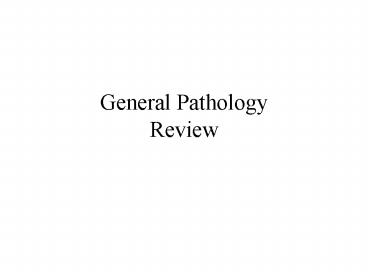General Pathology Review PowerPoint PPT Presentation
1 / 58
Title: General Pathology Review
1
General PathologyReview
2
Assumptions
- Studying pathology enables us to better treat
people - Normal people participate positively in the
society - Activity of the human is the product of all the
body systems - The organ is the functional unit of the body
- The cell is the structural unit of the body
3
Assumptions
- The human body can be divided into systems and
organs based on the Anatomy, and Tissues and
cells based on the Histology
4
Assumptions
- Pathology is any process that is not
physiological - Diseases can be explained by evidence of defects
in - The structure or
- The function or
- The activity or
- The participation of the human
5
Hypotheses
- There is a limited number of pathological
processes cell injury, cell death, adaptation,
inflammation, infectious, Fibrosis, immune
mechanism, genetic, developmental, hemodynamics,
metabolic, degenerative, and neoplastic - Each process may involve any system, organ,
tissue or cell
6
Hypotheses
- There are causes for each pathological process
- Clinical presentations can be explained by the
underlying pathological process - Complications arise if the pathology persists
7
Hypotheses
- We can control (manage) disease by focusing on
- The etiology
- The pathological process
- The clinical signs and symptoms
- The complications
8
Health and Disease
9
Pathological Processes
10
Cell Injury
11
Cell DeathNecrosisApoptosis
12
Patterns of necrosis
13
Cellular adaptationin Growthin differentiation
14
Injury and Response
15
Inflammation
16
Causes of Inflammation
17
Clinical Features of Inflammation
18
Acute inflammationOutcome of acute inflammation
19
Chronic Inflammation
20
Inflammatory diseases
21
Granulomatous inflammaioncauses
22
Lymphatics and lymph nodes
23
Chemical Mediators
24
Tissue Repair
25
RegenerationAbility of cells to proliferate
26
Fibrosis
27
Loss of function
28
Inflammatory diseases
29
Hemodynamic Disorders
30
Edema
31
CongestionHyperemiaIschemia
32
Hemorrhage
33
Shock
34
thrombosis
35
Virchow triad
36
Fate of thrombus
37
Embolism
38
Infarction
39
Neoplasia
40
Transformation
41
Benign vs Malignant
42
Rate of growthinvasionAnaplasiaMetastasis
43
Dysplasia
44
Monoclonality
45
Nomenclature
46
Genetic Defect
47
OncogenesTumor suppressor genesApoptosis genes
BCL-2DNA mismatch repair genesaging and
TelomeraseAngiogenesis
48
Mulistep carcinogenesis
49
Causes of neoplasiaHereditaryEnvironmental
50
Cancer
51
Preneoplstic disorders
52
Screening
53
Presentation of Cancer
54
Diagnosis of Neoplsm
55
Tumor markers
56
Grading of Cancer
57
Staging of Cancer
58
Prognosis

